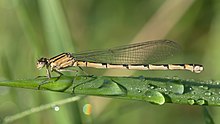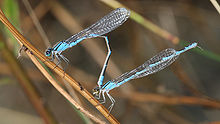Cup maids
| Cup maids | ||||||||||||
|---|---|---|---|---|---|---|---|---|---|---|---|---|

Common goblet maiden ( Enallagma cyathigerum ), male |
||||||||||||
| Systematics | ||||||||||||
|
||||||||||||
| Scientific name | ||||||||||||
| Enallagma | ||||||||||||
| Charpentier , 1840 |
The cup damsel ( Enallagma ) are a genus of the slender dragonflies (Coenagrionidae) within the small dragonflies (Zygoptera). Beaker dams are mainly found on the American double continent and are mainly found in the temperate zones of North America and Canada, where they represent the most species-rich genus of the dragonflies. In Europe, the genus is only represented by the common mugmaid ( Enallagma cyathigerum ). The very similar Enallagma deserti lives in Africa, north of the Sahara .
features
Cup maids are very slender, almost needle-shaped, with the females appearing a little stronger. They are mostly small dragonflies with wingspans and body lengths of around five centimeters. A relatively recent evolutionary split has led to a large number of species in North America, some of which are very similar and difficult to distinguish. A group of the cup maids is colored blue, with a characteristic black markings on the blue abdomen segments. Another group has a predominantly black abdomen with a mostly conspicuously colored area on the posterior abdominal segments. There is also a group of strong yellow to red colored dragonflies, as well as those that are purple in color.
Most species have species-specific bright postocular spots on the body-facing side of the compound eyes . These can vary in size from small and isolated spots or patches connected by a fine line to colored areas covering the entire width of the eyes. A color-contrasting, horizontal stripe in the middle of the eyes is typical of the females.
The drawing of the front body ( thorax ) is characterized by several longitudinal black lines, the dorsal median stripe is typically wider, the lateral humeral stripe rather narrower. The light area in between (antehumeral stripe) is usually wider than the humeral stripe below. The median is divided in the middle - rarely in males, more frequently in females - by the mostly fine, light-colored median seam; this narrow division is sometimes species-specific. On the sides of the thorax there are two shorter black lines, whereby the upper of the two in Enallagma species is only very rudimentary, with many slender dragonfly species there are two clear stripes here.

In the cup maids with blue abdomen there is a black mark at the caudal end of the abdominal segments, in the females mostly more extensive than in the males. Often this is described as "torpedo-shaped"; pointed at the front end, then running parallel and tapering again just before the bulging towards the rear end.
As is not uncommon in the subfamily of the Ischnurinae , the females come in different color variants. Androchromic females are colored like males, but the brownish or greenish heterochrome form with black markings is more common. In front of the ovipositor on the eighth abdominal segment there is a protruding thorn, which is also a characteristic of the Ischnurinae. In addition to the different color forms of the females, the final coloring of the adults only develops with the onset of sexual maturity. The newly hatched dragonflies are still without drawing, the youth color of the blue cup maids is a pale gray-brown, that of the dragonflies, which are later strongly yellow, a pale blue. In addition, at least some species are able to darken their bodies through a physiological change in color when the outside temperature is cold .
Similar genera

The azure maidens ( Coenagrion ) widespread in Europe as well as in North America are very similar to the cup maid, so that they can easily be confused with one another. In the past , the common mug maiden was often placed with the azure maid and was called Becher azure maiden in older identification books. In these, the lower abdominal appendages are slightly forked in the side view, the females lack the protruding thorn in front of the ovipositor on the eighth abdominal segment, typical of the subfamily Ischnurinae. The azure maidens have two clearly developed thoracic lateral stripes.
The cup maids are partly similar to the dragonflies of the genus Argia, which are common on the American double continent . The cup maids differ from the blue-colored representatives of this genus in that their eyes are dark on top; the genus Argia does not have this two-color division of the eyes. The female's horizontal eye stripe is also missing. The upper side of the second and tenth abdominal segment has no black markings like the cup maids, but Argia has a mark on the side of the second segment. The two genera also differ in behavior and flight.
Way of life
The cup maids have as different ecological demands as they are morphologically different. The group of blue-colored cup maids colonizes mostly still waters , while cup maids with black abdomen are more likely to be found in flowing waters . Some species live in brackish water zones, while others prefer alkaline desert corners for reproduction. The adults leave the water around 30 minutes after hatching, probably to avoid the risk of predation from adult dragonflies. Maturation far away from the hatching waters usually takes one to three weeks, the sexually mature male cup maids then gather at the breeding waters, while the females only visit them to mate and lay eggs. The main activity is usually around noon, and the cup maids often fly just above the surface of the water. Both sexes are usually no longer to be found in the late evening. Mating usually takes place around noon, the eggs are laid - often with the male attached - in submerged vegetation , rotting wood or algae mats. The females submerge and can spend up to an hour under water, but most of the time they lay eggs near the surface of the water. Cup maids like to rest on branches or leaves close to the bank and align themselves with the front body towards the water. In North America, two species of blue-colored goblet virgins are found relatively rarely in one area at the same time. Preferences for different habitat types, which at first glance appear very similar, seem to separate them, even if these mechanisms are not yet fully understood.
Naming

The German name is derived from the characteristic drawing on the second abdomen segment of the male common mug maiden, which is reminiscent of a stemmed mug. "Enallagma" ( Greek for swapping ) was chosen by Toussaint von Charpentier as the scientific generic name and was originally intended to apply to all slender vials whose male adults have a blue abdomen with black markings, including the azure maidens ( Coenagrion ) and the cup maid ( Erythromma lindenii ). The choice of name should emphasize the possibility of confusing the species concerned. In English, the name American Bluets - in contrast to the Eurasian Bluets , as the azure maidens are called - indicates the main focus of distribution.
species
According to Schorr et al. In 2013 the following 46 species were classified as cup maids:
- Enallagma ambiguum Navás , 1936
- Enallagma Anna Williamson , 1900
- Enallagma annexum ( Hagen , 1861)
- Enallagma antennatum ( Say , 1840)
- Enallagma aspersum ( Hagen , 1861)
- Enallagma basidens Calvert , 1902
- Enallagma boreale Selys , 1875
- Enallagma carunculatum Morse , 1895
- Enallagma circulatum Selys , 1883
- Enallagma civile ( Hagen , 1861)
- Enallagma clausum Morse , 1895
- Enallagma coecum ( Hagen , 1861)
- Enallagma concisum Williamson , 1922
- Enallagma cyathigerum ( Charpentier , 1840) - Common cup maiden
- Enallagma daeckii ( Calvert , 1903)
- Enallagma davisi Westfall , 1943
- Enallagma deserti Selys , 1871
- Enallagma divagans Selys , 1876
- Enallagma doubledayi ( Selys , 1850)
- Enallagma dubium Root , 1924
- Enallagma durum ( Hagen , 1861)
- Enallagma ebrium ( Hagen , 1861)
- Enallagma eiseni Calvert , 1895
- Enallagma exsulans ( Hagen , 1861)
- Enallagma geminatum Kellicott , 1895
- Enallagma hageni ( Walsh , 1863)
- Enallagma insula Fraser , 1920
- Enallagma laterale Morse , 1895
- Enallagma maldivense Laidlaw , 1902
- Enallagma minusculum Morse , 1895
- Enallagma novaehispaniae Calvert , 1907
- Enallagma pallidum Root , 1923
- Enallagma pictum Morse , 1895
- Enallagma pollutum ( Hagen , 1861)
- Enallagma praevarum ( Hagen , 1861)
- Enallagma recurvatum Davis , 1913
- Enallagma rua Donnelly , 1968
- Enallagma schmidti Steinmann , 1997
- Enallagma semicirculare Selys , 1876
- Enallagma signatum ( Hagen , 1861)
- Enallagma sulcatum Williamson , 1922
- Enallagma traviatum Selys , 1876
- Enallagma truncatum ( Gundlach , 1888)
- Enallagma vernale Gloyd , 1943
- Enallagma vesperum Calvert , 1919
- Enallagma weewa Byers , 1927
swell
literature
- John C. Abbott: Damselflies of Texas: a field guide , University of Texas Press, Austin 2011, ISBN 978-0-292-71449-6 .
- Klaas-Douwe B. Dijkstra: Field Guide to the Dragonflies of Britain and Europe . British Wildlife Publishing, Gillingham 2006, ISBN 0-953139948 .
- Dennis Paulson: Dragonflies and Damselflies of the East, Princeton Field Guides , Princeton University Press, New Jersey 2011, ISBN 978-0-691-12283-0 .
- Dennis Paulson: Dragonflies and Damselflies of the West, Princeton Field Guides , Princeton University Press, New Jersey 2000, ISBN 978-0-691-12281-6 .
- Jill Silsby: Dragonflies of the World . Smithsonian, Washington 2001, ISBN 1-560-98959-9 .
- Klaus Sternberg, Rainer Buchwald (ed.): The dragonflies of Baden-Württemberg. Volume 1: General part, dragonflies (Zygoptera). Verlag Eugen Ulmer, Stuttgart 1999, ISBN 3-8001-3508-6 .
Individual evidence
- ↑ a b c d e f g h i j Dennis Paulson: American Bluets. In Dragonflies and Damselflies of the East , p. 85.
- ^ A b John C. Abbott: Bluets, Genus Enallagma . In Damselflies of Texas , pp. 105-106.
- ↑ Reinhard Jödicke: Enallagma 'American Bluets'. In Dijkstra: Field Guide to the Dragonflies of Britain and Europe , pp. 101 ff.
- ^ Jill Silsby: Subfamily Ischnurinae (Blue-tailed Damselflies). In Dragonflies of the World . Smithsonian, Washington 2001, ISBN 1-560-98959-9 , pp. 110-112.
- ↑ K. Sternberg: Thermoregulation. In Sternberg, Buchwald: The dragonflies of Baden-Württemberg. Volume 1 , p. 133 ff.
- ↑ Dr. Heinrich Fliedner: The scientific names of dragonflies in Burmeister 's 'Manual of Entomology' . In Virgo, bulletin of the Mecklenburg Entomological Association 9/2006 ( Download ; PDF; 227 kB).
- ^ Martin Schorr, Dennis Paulson: World Odonata List. Update from February 5, 2013 ( download ).
